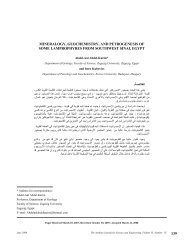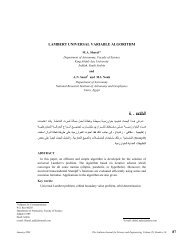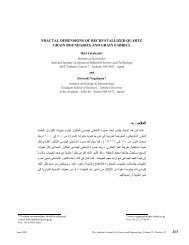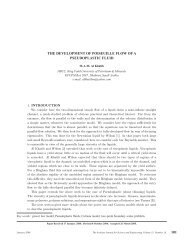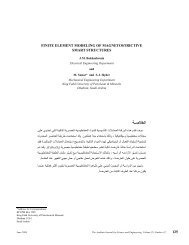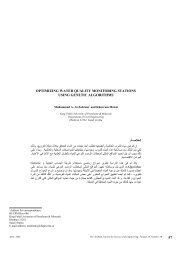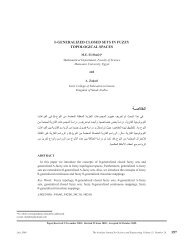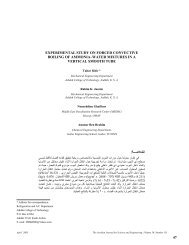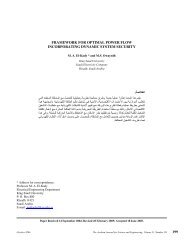HYDRODESULFURIZATION OF THIOPHENE OVER BIMETALLIC ...
HYDRODESULFURIZATION OF THIOPHENE OVER BIMETALLIC ...
HYDRODESULFURIZATION OF THIOPHENE OVER BIMETALLIC ...
Create successful ePaper yourself
Turn your PDF publications into a flip-book with our unique Google optimized e-Paper software.
<strong>HYDRODESULFURIZATION</strong> <strong>OF</strong> <strong>THIOPHENE</strong> <strong>OVER</strong><br />
<strong>BIMETALLIC</strong> Ni–Mo SULFIDE CATALYSTS PREPARED<br />
BY DIFFERENT METHODS<br />
Hamid A. Al-Megren*<br />
Petroleum and Petrochemicals Research Institute, King Abdulaziz City for Science and<br />
Technology, P.O. Box 6086 Riyadh 11442, Saudi Arabia<br />
Hamid A. Al-Megren<br />
: ةـصلاخلا<br />
ة���يكيناكيملا (IMPR) بير���شتلا ق���يرط ةطا���سوب ند���عملا يئا���نث Ni–MO/Al2O3 د���يتيربك ن���م تاز ّ◌ّـ���فحم ري���ضحت - ث���حبلا اذ���ھ ي���ف - م���ت د���قل<br />
ةع�شأ فار�حناو ،نيجورتينلا�ب يئا�يزيفلا زاز�تملاا ةطا�سوب تاز�فحملا صاو�خ د�يدحت ﱠمت امك . (OMXC) ةيوضعلا Matrix قرـح ةقيرطو (MECH)<br />
ت�يربكلا عزن ةيلمع يف اھتيلاعف ةساردو ةرضحملا تازفحملل ةترْبَك ةيلمع تيرجأ دقو . نامار فايطمو ينورتكللإا سجملا ةطاسوب قيقدلا ليلحتلاو<br />
سكإ<br />
ة��يلاعف ر�ثكأ (OMXC) ة��قيرطب هري�ضحت م��ت يذ�لا ز��فحملا نأ�ب د��جُو د�قو . م٣٥٠<br />
ةرار��ح ة�جردو د��حاو يو�ج طغ��ض ت�حت نيفو��يثلل (HDS) ة�جردھلاب<br />
. IMPR و MECH قرطب ةرضحملا تازفحملا عم ةنراقم % ٥٧ يلاوحب<br />
ABSTRACT<br />
Bimetallic Ni–Mo sulfide Al2O3 catalysts were prepared by impregnation (IMPR), mechanical (MECH) and<br />
organic matrix combustion (OMXC) methods. The prepared catalysts were characterized by nitrogen physisorption,<br />
X-ray diffraction, electron probe microanalysis, and Raman Spectroscopy. The samples were sulfided and their<br />
activity in hydrodesulfurization (HDS) of thiophenes at a pressure of 1 atm and a temperature of 350ºC was tested. It<br />
was found with Ni–Mo that the catalyst prepared by the OMXC method is more active (by upto 57%) as compared<br />
with the corresponding catalysts prepared by (MECH) and conventional impregnation methods.<br />
Key words: bimetallic HDS catalyst, preparation, characterization<br />
* E-mail: almegren@kacst.edu.sa<br />
Paper Received: 17 November 2007; Accepted 12 November 2008<br />
The Arabian Journal for Science and Engineering, Volume 34, Number 1A January 2009 55
56<br />
Hamid A. Al-Megren<br />
<strong>HYDRODESULFURIZATION</strong> <strong>OF</strong> <strong>THIOPHENE</strong> <strong>OVER</strong> <strong>BIMETALLIC</strong> Ni–Mo SULFIDE<br />
CATALYSTS PREPARED BY DIFFERENT METHODS<br />
1. INTRODUCTION<br />
At present, the hydrodesulfurization (HDS) process is an efficient method for sulfur removal from gasoline and<br />
diesel of high sulfur content [1,2]. In the HDS process, organic sulfur compounds in the liquid fuels are broken<br />
down to H2S using NiMo–CoMo/Al2O3 catalysts [3–6], followed by the removal of H2S, and the sulfur content in<br />
fuels can be reduced to about 10 ppm. Sulfided Ni–Mo catalysts are widely used in hydrotreating reactions [7,8].<br />
Several studies have shown that monometallic cobalt catalyst are active for hydrodesulfurization (HDS) reactions<br />
[9–11]. For example, Duchet et al. investigated carbon supported molybdenum and tungsten catalysts for HDS of<br />
thiophenes [12]. In some cases, however, their HDS activities are low and unimportant due to a low degree of cobalt<br />
dispersion and/or strong interactions with some support materials like alumina [13]. Therefore it is of great interest<br />
to examine the influence of the preparation method on the properties and activity of the catalyst, as well as on the<br />
interaction between promoters and supports [14]. In the present investigations, emphasis was focused on studying<br />
the effect of the preparation method on the hydrodesulfurization activity of Ni–Mo catalysts.<br />
To improve the performance of the HDS catalyst, all steps in the preparation procedure should be considered.<br />
The key parameters are the choice of a precursor of the active species, support, synthesis, and post-treatment of the<br />
synthesized catalyst. The nature of the active phase can be modified by changing the amount of active component<br />
[15], and by the introduction of additives. Numerous additives have been studied, and phosphorus [16, 17] and<br />
fluorine [18–21] have received special attention. In some studies, the sulfides of transition metals were replaced by<br />
nitrides [22] or carbides [23, 24]. Noble metals are also used as the active phase in hydrotreating catalysts for second<br />
stage HDS [25].<br />
Various supports have been used to enhance the catalytic activity in HDS: carbon [26–28], silica [29, 30],<br />
zeolites [31–34], titania and zirconia [35–37], and silica–alumina [38, 39]. Combining new types of catalytic species<br />
with advanced catalyst supports such as ASA (amorphous silica–alumina) can result in an extremely high<br />
desulfurization performance. The application of ASA-supported noble metal-based catalysts for the second-stage<br />
deep desulfurization of gas oil is an example [25]. The Pt and Pt–Pd catalysts are very active in the deep HDS of prehydrotreated<br />
straight run gas oil under industrial conditions. These catalysts are able to reduce the sulfur content to 6<br />
ppm, while simultaneously reducing the aromatics to 75% of their initial amount. At high sulfur levels, the ASA<br />
supported noble metal catalysts are poisoned by sulfur and Ni–W–ASA catalysts become preferable for deep HDS<br />
and dearomatization.<br />
It has long been recognized that the optimal performance of a catalyst depends on its preparation method [40].<br />
The common preparation methods require a combination of different unit operations. Some of these are not entirely<br />
understood. They can be described as: (i) introduction of the metal precursor on the support by impregnation or ionexchange<br />
[41], co-precipitation and deposition precipitation [42]; (ii) drying and calcination, and (iii) reduction. The<br />
size and distribution of metal crystallites in the support, the homogeneity of the multi-component catalyst, the<br />
porosity, surface area, and pore size distribution are all functions of the precursors used in the preparation. Some<br />
preparation parameters such as temperature of treatment, pH of the solution and the aqueous or organic medium also<br />
contribute to the catalyst preparation. Recently, significant progress has been made towards understanding the<br />
relationship between the preparation method and final properties of the catalyst and supports [41]. Generally, it is<br />
believed that the catalyst selectivity depends on the particle size of the dispersed metal and spatial distribution of the<br />
active component in the porous support. The stability of the catalyst depends on the interaction of the metal and the<br />
supports.<br />
The controlled preparation of heterogeneous catalysts has been studied for more than 100 years [42]. However,<br />
perfectly designed catalysts still remain a challenge. Impregnation, sol–gel, ion-exchange, precipitation, and<br />
deposition-precipitation are the commonly used methods [43].<br />
The impregnation method requires the support to be contacted with a certain amount of solution of a metal<br />
precursor, usually a salt, and then it is aged, usually for a short time, dried, and calcined [41]. This method appears to<br />
be simple, and economical (especially when using solutions of costly active components), and able to yield a<br />
reproducible catalyst. However, when drying, the dissolved metal compounds often crystallize in the support, which<br />
leads to larger crystallites and thus leading to low metal dispersion.<br />
The ion–exchange method consists of exchanging either hydroxyl groups or protons from the supports, with<br />
cations and anions in the solutions [41]. In this method, it is important to adjust the pH values to control the<br />
interaction between the support and metal precursors. A knowledge of the isoelectric point is essential if meaningful<br />
dispersions are to be obtained.<br />
January 2009 The Arabian Journal for Science and Engineering, Volume 34, Number 1A
Hamid A. Al-Megren<br />
The sol–gel method is the latest technique for catalyst preparation, in which the metal–organic precursors are<br />
mixed with metal precursor to form a homogeneous solution [43]. The solution is passed through the hydrolysis and<br />
polymerization process by adding water while carefully controlling the pH and reaction temperature. This results in<br />
the formation of colloidal particles and micelles of approximately 10 nm diameter. These particles continue to<br />
increase in size until a metal oxide gel is formed.<br />
However, each of these techniques is either difficult to control or the preparation process is complex and difficult<br />
to use on an industrial scale. Also, none of them ever takes into consideration the adjustment of the interaction<br />
between the active metal and support, which is regarded as one of the properties of supported catalysts.<br />
Also, for hydrotreating catalyst preparation, the content and particle sizes of the active components such as Mo or<br />
W are crucial for the catalyst performance. No methods are available to load the high content of the Mo or W needed<br />
with desirable particle size. Hence, selective deep removal HDS now needs noble metal catalysts, which are much<br />
more costly and easy to deactivate.<br />
Recently, a new catalyst preparation method, i.e. organic matrix combustion (OMXC) has been developed [44,<br />
45]. Some organic compounds are mixed with soluble metal compounds to form a homogeneous solution with<br />
addition of minimum water (or other solvent) where necessary. The particle size of the catalyst is controlled by the<br />
ratio of the organic compounds to the metal in the solution. Interaction between the active component and support is<br />
controlled by the calcinations temperature and atmosphere.<br />
The aim of this work is to develop more robust catalysts with high activity for selective removal of sulfur from<br />
thiophene, to hydrogenate the C–S bond; and with low ability to hydrogenate the mono C=C bonds. The key to<br />
achieving this goal is to control the distribution and particle size of the active component, e.g. MoS2, and optimize<br />
the promotion of Ni and Mo in the catalysts supported over alumina. Active component precursors will be chosen<br />
from the ammonium salts. This catalyst will be prepared and compared by three different preparation methods.<br />
2. EXPERIMENTAL<br />
2.1. Catalyst Preparation<br />
In this work, 15% Ni–Mo bimetallic material supported over alumina was prepared using three different<br />
methods: impregnation (IMPR), mechanical (MECH), and organic matrix combustion (OMXC). All catalysts were<br />
prepared in oxide phase then sulfurized using a stream of hydrogen saturated by thiophene at room temperature.<br />
Nickel nitrate hexahydrate Ni(NO3)2.6H2O(99.0% Fluka) was mechanically mixed with molybdenum trioxide at<br />
a Ni/Mo atomic ratio of 0.43. An amount of 15% from the mixture was added to alumina (150 mesh, 150 m 2 g -1 , from<br />
Aldrich). The mixture was dried in a vacuum oven at 120ºC and calcined at 550ºC for 15 hours. The resulted powder<br />
sample was named as MECH.<br />
Nickel nitrate hexahydrate was dissolved in small amount of water, mixed with ammonium<br />
heptamolybdatetetrahydrate (NH4)6Mo7O24-4H2O (99% Riedel-de Haën) then impregnated with alumina. The<br />
mixture was dried in a vacuum oven and calcined at 550ºC for 15 hours. The resulted powder sample was named as<br />
IMPR.<br />
The same ratio of Ni/Mo supported over alumina was prepared using OMXC method by mixing calculated<br />
amount of urea (Fisher Chemicals) with ammonium heptamolybdate-tetrahydrate and nickel nitrate hexahydrate<br />
(Ca.1g/2ml = (Ni- and Mo-Precursors+urea)/ water ratio. This mixture was stirred to form a homogeneous slurry,<br />
then mixed with Al2O3 support and heated at 50ºC for 2-3 hours to obtain urea-based slurry containing molybdenum<br />
fully loaded over alumina. This paste is ignited at 500ºC in static air for 10 min. The resulted powder sample was<br />
named as OMXC.<br />
2.2. Catalytic Tests<br />
All catalysts were activated by sulfurization using 20 ml of hydrogen through a jacketed saturator containing<br />
thiophene (10.9 kPa). The flow of hydrogen with thiophene passed through 200mg of catalyst placed in a fixed bed<br />
reactor and heated at 5ºC/min to maximum temperature 450ºC, and was then held at this temperature for 3 hours.<br />
The catalytic behavior tests of the prepared supported catalysts (MECH, IMPR, and OMXC) for the<br />
hydrodesulfurization of thiophene were carried out in a laboratory bench scale pilot plant fitted with mass flow<br />
meters and a fixed bed down-pass flow quartz reactor placed in a cylindrical furnace, equipped with a coaxial<br />
thermocouple. The inner diameter for the reactor was 4 mm and its length 300 mm. The catalyst zone in the middle<br />
of the reactor had a length of 30 mm and was filled with 200 mg of catalyst diluted with an equal amount of quartz<br />
particles (50 – 100 mesh) in order to minimize temperature gradients. In the center of the catalyst bed, a<br />
thermocouple was installed in contact with the catalyst particles to measure the reaction temperature. The heating<br />
zones at the inlet and the outlet of the reactor were measured by a thermocouple located inside the furnace and were<br />
controlled by a temperature controller (Cole Parmer Digi-Science).<br />
The Arabian Journal for Science and Engineering, Volume 34, Number 1A January 2009 57
58<br />
Hamid A. Al-Megren<br />
Normally, the flow rate of hydrogen was 20 ml/min at atmospheric pressure. The activity of nickel–molybdenum<br />
supported catalysts (MECH, IMPR, and OMXC), and thiosophene conversion were studied at a temperature of<br />
350°C<br />
Blank reactor runs were conducted as described above in the absence of catalysts. No significant conversions of<br />
thiophenes were observed under the conditions of each experiment. Carbon mass balancing closed within 8%, most<br />
within 5%.<br />
2.2.1. Gas Chromatography<br />
The analysis of the reaction mixture was carried out using, a Hewlett–Packard 5890 series II. The instrument<br />
equipped with 1 × 1/8" O.D. stainless steel packed column (80 – 100 mesh range Porpak S); and flame ionization<br />
detector (FI), and thermal conductivity detector (TCD).<br />
The instrument was calibrated by external standardization method using standard mixture of (CH4, C2H6, C2H4,<br />
C3H8, C3H6, C4H10, C4H8, and C4H8).<br />
2.3. Catalyst Characterization<br />
Electron probe micro-analyzer (EPMA) (JEOL JXA-8900R/RL) was used for identification of constituent<br />
elements in the prepared samples and to study the elements distribution over the support. Analysis was performed<br />
by illuminating the sample surface with a finely focused electron beam and measuring the wavelengths and<br />
intensities of characteristic X-rays from the specimen and the quantities of secondary electrons and backscattered<br />
electrons from it.<br />
The X-ray diffraction (XRD) was carried out in Philips PW1710 diffractometer with CuKα radiation. The data<br />
were collected at room temperature, in θ/θ reflection mode, scanning the specimen between 3º–70º in 2θ, using steps<br />
of 0.05º, with a time per step of 1.25 s.<br />
The structure of the samples was studied using laser Raman spectroscopy from a Jobin Yvon Labram<br />
spectrometer with a 632.8 nm HeNe laser, run in a back-scattered confocal arrangement. The samples were pressed<br />
in a microscope slide; the scanning time was set to 30s. Raman spectra were recorded in air at room temperature<br />
with a resolution of 2 cm –1 and a scanning range of 100 to 2500 cm –1 .<br />
2.3.1. Physisorption<br />
Nitrogen adsorption–desorption isotherm of MECH, IMPR, and OMXC catalyst samples were measured on a<br />
Micromeretics ASAP2010 system using nitrogen sorption at 77K. Prior to the experiments, approximately 0.2 g of<br />
sample was degassed at 523K for 16h. The surface areas were calculated using a multipoint Brunauer–Emmett–<br />
Teller (BET) model. The pore size distribution was obtained using BJH and BET models and the total pore volumes<br />
were estimated at a relative pressure of 0.99 atm, assuming full surface saturation with nitrogen.<br />
For characterization purpose, samples of the fresh and used catalyst were passivated at room temperature in flow<br />
of 1% O2/He before they were exposed to air.<br />
3. RESULTS AND DISCUSSION<br />
The surface area measurements for the three prepared bimetallic catalyst samples (MECH, IMPR, and OMXC) in<br />
oxide phase, before sulfurization, are shown in Table 1. The surface areas for the samples increase in following<br />
order: MECH (125.5 m 2 /g) > OMXC (122.5 m 2 /g) > IMPR (119.3 m 2 /g); the differences are relatively small. The<br />
highest surface area for the sample prepared by mechanical method could be attributed to less dispersion between the<br />
active component and surface of the support. In Table 1, the average pore diameter and the total volume, measured<br />
for the three samples, were the highest for the samples prepared by mechanical and the lowest for the sample<br />
prepared by combustion method. The particle size distribution analysis shows that the samples prepared by IMPR<br />
and OMXC have almost similar size (~60μm), much higher than the particle size for sample prepared by MECH<br />
(~27μm).<br />
Table 1. Physical Properties of NiMoOx Catalyst Prepared by Impregnation, Mechanical, and Organic Matrix<br />
Methods<br />
Preparation Surface<br />
Method Area m 2 g -1<br />
Total Pore Volume<br />
Cm 3 g -1<br />
Average Pore Particle Size<br />
Diameter A º Distribution μm<br />
IMPR 119.27 0.16529 55.436 59.81<br />
OMXC 122.50 0.16420 53.617 63.53<br />
MECH 125.51 0.18621 59.343 26.81<br />
January 2009 The Arabian Journal for Science and Engineering, Volume 34, Number 1A
Count/arb, units<br />
500<br />
400<br />
300<br />
200<br />
100<br />
Hamid A. Al-Megren<br />
0<br />
0 10 20 30 40 50 60 70<br />
2 q<br />
Figure 1. XRD pattern for Ni3Mo7Ox/Al2O3 catalysts prepared by Impregnation, Mechanical and OMXC methods<br />
The Arabian Journal for Science and Engineering, Volume 34, Number 1A January 2009 59<br />
Al<br />
Al<br />
Al<br />
Al<br />
Al<br />
OMXC<br />
Al<br />
The X-ray diffraction patterns for the three samples in oxide phase are shown in Figure 1. Sample MECH shows<br />
an appearance of MoO3 peaks at 2θ values of 14.4, 23.6, and 26.8º. Sample IMPR also shows slight appearance of<br />
MoO3 peak at 2θ values of 23.6º, while there is no appearance of these peaks on the sample prepared by OMXC<br />
method. These appearances of the MoO3 peaks suggest that both methods, mechanical and impregnation, lead to<br />
lower dispersion of the active component compared to OMXC method, which enables a high dispersion of<br />
Ni3Mo7Ox.<br />
Raman spectroscopy is a powerful tool to study the structure of catalytically active phases on a support. Typical<br />
support such as alumina shows weak Raman scatters, with consequence that adsorbed species can be measured at<br />
frequencies as low as 50 cm –1 [10]. Figures 2, 4, and 8 show the Raman spectra of the oxides and sulfided phase for<br />
the catalysts in the 200–2000 cm –1 range. The spectra of Ni3Mo7Ox/Al2O3 catalysts do not exhibit the features of<br />
Ni3Mo7Sx/Al2O3 catalysts. The Raman spectra of NiMoOx/Al2O3 bimetallic supported oxide samples prepared using<br />
the three methods are shown in Figure 2. It shows that the main phase on the surface of samples IMPR and MECH<br />
is MoO3. The Raman band on these samples at 995 cm –1 corresponds to the stretching mode of Mo=O, and the band<br />
at 830 cm –1 corresponds to the anti-symmetric stretching mode of Mo–O–Mo, and the band at 295 cm –1 corresponds<br />
to the bending mode of Mo=O in the polycrystalline MoO3. The strong band at 965 cm –1 on sample MECH is due to<br />
the A1 mode of Mo=O in the MoO4 tetrahedral units. The broad band for samples IMPR and OMXC at 955 cm –1 ,<br />
which can be unfolded into two peaks at 955 and 965 cm –1 , highlights the band characteristic of NiMoO4. The<br />
Raman results suggest that the main oxide present clearly on the surface of sample MECH and IMPR is MoO3. Our<br />
findings agree with those reported by Sergio et al. [46, 47]. In addition, the shoulder of 950 cm –1 and the weak<br />
Raman bands at about 825 cm –1 are associated with the Mo–O–Mo for the polymolybdate species [48–51]. On the<br />
other hand, the weak intensity band at 950 cm –1 is characteristic of Ni–Mo oxide.<br />
Ramman Pand Intincety<br />
4500<br />
4000<br />
3500<br />
3000<br />
2500<br />
2000<br />
1500<br />
1000<br />
500<br />
MECH<br />
OMXC<br />
I MPR<br />
Al<br />
MECH<br />
I MPR<br />
0<br />
0 500 1000 1500 2000<br />
Ramman Shift, cm -1<br />
Figure 2. Laser Raman spectra for Ni 3Mo 7O x/Al 2O 3 catalysts prepared by Impregnation, Mechanical and OMXC methods
60<br />
Hamid A. Al-Megren<br />
Figure 3 shows the X-ray diffraction patterns for the three samples after the sulfidation reaction. It is clear that<br />
the main peaks for the oxide phase, i.e. MoO3 at 2θ values 14.4, 23.6, and 26.8, have disappeared from IMPR and<br />
OMXC samples while they have weakened on the MECH sample. This disappearance was attributed to the higher<br />
formation of sulfide phase on IMPR and OMXC, while some oxides still remain on MECH sample. Our results<br />
agreed with those reported by some investigators [48]. They have shown that during the primary period of<br />
thiophenes hydrodesulfurization on MoO3, a definite amount of sulfur was consumed by sulfidation of the oxide.<br />
This means that oxidic molybdenum catalyst can be sulfided by thiophenes, or by the hydrogen sulfide produced by<br />
DHO of thiophenes.<br />
Count/unit<br />
400<br />
300<br />
200<br />
100<br />
0<br />
10 20 30 40 50 60 70<br />
January 2009 The Arabian Journal for Science and Engineering, Volume 34, Number 1A<br />
2 q<br />
MECH<br />
OMXC<br />
I MPR<br />
Figure 3. XRD pattern for Ni 3Mo 7S x/Al 2O 3 catalysts prepared by Impregnation, Mechanical and OMXC methods<br />
The laser Raman spectra of the three samples (IMPR, MECH, and OMXC) after converting them from oxide to<br />
sulfide phase by sulfurization reaction are shown in Figure 4. The spectrum intensity of oxide phase (Figure 2) was<br />
highly reduced after sulfurization reaction. The vibration frequency at band 965 cm –1 Mo=O in the MoO4 tetrahedral<br />
units is strongly reduced after sulfurization. This band, i.e. 965 cm –1 disappeared completely on OMXC sample but it<br />
was partially reduced on rest of the samples. This result suggests that the molecular symmetry mode in the surface of<br />
MoO3 was changed after sulfurization [46–47]. In addition the spectrum of Figure 4 shows two bands at about 440<br />
and 450 cm –1 which could be attributed to MoS2 structure [13]<br />
1000<br />
Raman band intensity / Arb. units<br />
800<br />
600<br />
400<br />
200<br />
0<br />
MECH<br />
OMXC<br />
IMPR<br />
500 1000 1500 2000<br />
Raman shift, cm -1<br />
Figure 4. Laser Raman spectra for Ni 3Mo 7S x/Al 2O 3 catalysts prepared by Impregnation, Mechanical and OMXC methods
Hamid A. Al-Megren<br />
In the present study, the catalytic activity of sulfided NiMo/Al2O3 catalysts (IMPR, OMXC, MECH) were<br />
examined in the hydrodesulfurization of thiophenes at a temperature of 350°C and under atmospheric pressure. The<br />
conversion of thiophenes is shown in Figure 5. It can be observed that thiophenes conversion is constant over about<br />
8 h time on stream. Thus, high catalytic activity (57% of thiophenes conversion) is reached for the catalyst OMXC.<br />
Catalytic activities of IMPR and MECH catalysts are lower (45% and 21% of thiophene conversion respectively).<br />
The rate of reactions also show in order 73.80, 58.16, and 26.05 µmol (g min) –1 for OMXC, IMPR, and MECH<br />
respectively. The superior activity of OMXC catalyst is attributed to the incorporation of Ni–Mo onto the support<br />
surface. This provides a stronger metal–support interaction allowing a better dispersion of nickel and molybdenum<br />
oxidic and sulfided phases. On the other hand, too strong metal–support interaction makes the reduction and<br />
sulfidation of Ni and Mo species more difficult.<br />
Conversion, %<br />
60<br />
50<br />
40<br />
30<br />
20<br />
10<br />
OMXC<br />
0<br />
0 1 2 3 4 5 6 7 8<br />
Time, hour<br />
The Arabian Journal for Science and Engineering, Volume 34, Number 1A January 2009 61<br />
IMPR<br />
MECH<br />
Figure 5. HDS of thiophene over Ni 3Mo 7S x/Al 2O 3 catalysts at 350ºC, atmospheric pressure and 20ml/min flow of hydrogen<br />
This is in agreement with the results of Klimova et al. [53] who found NiMo catalysts supported on Al-SBA-16,<br />
prepared by grafting with AlCl3, show high activity in HDS of 4,6-DMDBT which attributed a good dispersion of Ni<br />
and Mo active phases.<br />
The catalytic activity for these catalysts was tested on hydrodesulfurization of thiophene at 350 o C and<br />
atmospheric pressure. Figure 5 shows that OMXC catalyst has superior activity (57%) compared to IMPR (45%) and<br />
MECH (21%) catalysts after seven hour of the reaction time. The rates of reaction also show in order 73.80, 58.16,<br />
and 26.05 umol (g min) –1 for OMXC, IMPR, and MECH respectively. This superior activity for OMXC sample<br />
attributed to the well dispersion of Ni–Mo over alumina as well as the higher sulfide formation compare to IMPR<br />
and MECH [46].<br />
= Ratio<br />
C 4 /C 4<br />
2.6<br />
2.5<br />
2.4<br />
2.3<br />
2.2<br />
2.1<br />
IMPR<br />
MECH<br />
OMXC<br />
2.0<br />
0 1 2 3 4 5 6 7 8<br />
Time, hour<br />
Figure 6. C4/C4= mol ratio for HDS of Thiophene over Ni3Mo7Sx/Al2O3 catalysts at 350ºC, atmospheric pressure and 20ml/min<br />
flow of hydrogen.
62<br />
Hamid A. Al-Megren<br />
Figure 6 shows the ratios of butane and butenes (C4/C4 = ), which are produced from HDS of thiophene reaction.<br />
The OMXC catalyst yielded the highest content of olefins, as compared to the IMPR catalyst. Products distribution<br />
data provide some insight into the possible pathway of thiophene desulfurization, which is difficult to extract from<br />
similar catalysts in which products are substantially altered by high rates of hydrogenation and isomerization<br />
reactions.<br />
More important are the differences between the three catalysts (IMPR, MECH, and OMXC) when we consider<br />
the product distributions. GC analysis showed the formation of mainly C4 and C4 = fractions, but it has not showed<br />
the formation of tetrahydrothiophene and butadiene. However many authors have argued for the preferential direct<br />
desulfurization route, by the absence of tetrahydrothiophene [50].<br />
Therefore our result shows that the pathway of reaction is the direct hydrodesulfurization route with successive<br />
hydrogenation, as shown in Scheme 1.<br />
S<br />
HDS<br />
HD<br />
S<br />
HD<br />
HDS<br />
HD<br />
HDS<br />
Scheme 1<br />
With the three catalysts, the ratio of C4 to C4 = is around 2.5.<br />
This suggests butane generation by hydrogenation of C4 compounds. These compounds are produced through the<br />
hydrogenolysis of thiophene and probably from β-H elimination from intermediate hydrogenated thiophenes [55].<br />
Table 2 shows the chemical analysis for the three samples analyzed before and after HDS reaction for more than<br />
seven hours. The sulfur content for the three samples increased after the HDS reaction. This sulfur content increase<br />
could be attributed to formation of sulfur species during the HDS reaction by the oxide phases that remain in the<br />
sample. The sample prepared by OMXC method shows more chemical stability compared to the samples prepared<br />
by other methods. The reaction rate was calculated for the HDS reaction over the three different catalysts. The<br />
catalyst prepared using OMXC method a shows higher reaction rate than IMPR and MECH.<br />
Table 2. Chemical Analysis for NiMoS Catalyst before and after HDS of Thiophene Reaction at 350ºC and<br />
Atmospheric Pressure<br />
Methods Before Reaction % After Reaction % Reaction rate<br />
Al Mo Ni S Al Mo Ni S μmol (g min) -1<br />
IMPR 47.28 24.49 7.41 20.81 41.61 24.36 5.61 28.42 58.16<br />
OMXC 46.63 18.60 9.68 25.10 42.46 19.31 9.50 28.74 73.80<br />
MECH 45.34 18.64 11.35 24.67 36.52 19.74 12.45 31.29 26.05<br />
The structure stability after the HDS reaction for the three samples was analyzed by X-ray and Raman<br />
spectroscopy. The X-ray patterns (Figure 7) for all the samples show higher structure stability after the HDS<br />
reaction. The remaining peaks of MoO3 over the MECH sample after sulfurization reaction were converted to the<br />
sulfide phase.<br />
Raman spectra for the three samples after HDS reaction are shown in Figure 8. It is shown that all bands for<br />
Mo=O and Mo–O–Mo vibrations at 995 cm –1 and 830 cm –1 on the IMPR sample are eliminated during the HDS<br />
reaction. There is also a reduction in band 965 cm –1 for the MECH sample.<br />
January 2009 The Arabian Journal for Science and Engineering, Volume 34, Number 1A<br />
HD
Count/arb. units<br />
500<br />
400<br />
300<br />
200<br />
100<br />
0<br />
0 10 20 30 40 50 60 70<br />
Hamid A. Al-Megren<br />
Figure 7. XRD pattern for Ni 3Mo 7S x/Al 2O 3 catalysts used for HDS reaction at 350ºC, atmospheric pressure and 20ml/min flow of<br />
hydrogen.<br />
Ramman Band Intincity<br />
1000<br />
800<br />
600<br />
400<br />
200<br />
0<br />
2 q<br />
The Arabian Journal for Science and Engineering, Volume 34, Number 1A January 2009 63<br />
MECH<br />
OMXC<br />
I MPR<br />
MECH<br />
OMXC<br />
I MPR<br />
500 1000 1500 2000<br />
Ramman Shift. cm -1<br />
Figure 8. Laser Raman spectra for Ni 3Mo 7S x/Al 2O 3 catalysts used for HDS at 350ºC, atmospheric pressure and 20ml/min flow of<br />
hydrogen.<br />
4. CONCLUSION<br />
The Ni–Mo–Al2O3 catalysts were prepared by impregnation (IMPR), Mechanical (MECH), and organic matrix<br />
combustion (OMXC) methods. The differences in the surface area of the catalysts are relatively small and range<br />
between 119.3, 122.5, and 125.5 m 2 /g for MECH, OMXC and IMPR respectively. XRD examination of IMPR,<br />
MECH, and OMXC catalysts indicated high dispersion of Ni3Mo7Ox in the OMXC catalyst as compared to the<br />
MECH and IMPR catalysts. XRD also indicated the disappearance of MoO3 after sulfidization of the catalysts. This<br />
could be attributed to higher formation of the sulfide phase. The disappearance of MoO3 was also observed in the<br />
Raman spectra.<br />
It was found that the OMXC catalyst has superior activity towards HDS of thiophenes, as compared to IMPR and<br />
MECH catalysts.
64<br />
Hamid A. Al-Megren<br />
In summary, a new method has been developed to prepare HDS catalyst and this catalyst has been compared with<br />
catalysts prepared by the conventional methods for selective thiophene HDS. This method enables a high dispersion<br />
of the molybdenum oxide and sulfide, resulting in higher activity and high yield of olefin in thiophene HDS.<br />
ACKNOWLEDGMENT<br />
The author would like thank Eng. Saeed Alshihri, Eng. Saud Aldrees, and Mr. Rasheed Al-Rasheed for their help<br />
in experimental work in the laboratories of King Abdulaziz City for Science and Technology. The author would<br />
also like to thank the Inorganic Chemistry Laboratory (ICL) at the University of Oxford, England, for their<br />
assistance in this research.<br />
REFERENCES<br />
[1] C. Song, X. Ma, “New Design Approaches to Ultra-Clean Diesel Fuels by Deep Desulfurization and Deep<br />
Dearomatization”, Appl. Catal. B: Environ.,41(2003), p. 207.<br />
[2] V. Babich and J.A. Moulijn, “Science and Technology of Novel Processes for Deep Desulfurization of Oil Refinery<br />
Streams: a Review”, Fuel, 82(2003), p. 607.<br />
[3] H. Topsøe, B.S. Clausen, and F.E. Massoth, Catalysis, Science and Technology, vol. 11. Berlin: Springer-Verlag,<br />
1996.<br />
[4] R. Prins, H.J. de Beer, and G.A. Somorjai, “Structure and Function of the Catalyst and the Promoter in Co–Mo<br />
Hydrodesulfurization Catalysts”, Catal. Rev.-Sci. Eng., 31(1989), p. 1.<br />
[5] P.T. Vasudevan and J.L.G. Fierro, “A Review of Deep Hydrodesulfurization Catalysis”, Catal. Rev.-Sci. Eng.,<br />
38(1996), p. 161.<br />
[6] R. Prins, “Catalytic Hydrodenitrogenation”, Adv. Catal., 46(2001), p. 399.<br />
[7] M. Zdrazil, “Recent Advances in Catalysis over Sulphides”, Catal. Today, 3(1988), p. 269.<br />
[8] R. Prins, V.H.J. de Beer, and G.A. Somorjai, “Structure and Function of the Catalyst and the Promoter in Co–Mo<br />
Hydrodesulfurization Catalysts”, Catal. Rev.-Sci. Eng., 31(1989), p. 1.<br />
[9] J.T. Kloprogge, W.J.J. Welters, et al. “Catalytic Activity of Nickel Sulfide Catalysts Supported on Al-Pillared<br />
Montmorillonite for Thiophene Hydrodesulfurization”, Appl. Catal. A Gen., 97(1993), p. 77.<br />
[10] E. Hayashi. et al. “High Surface Area Smectite Supported Cobalt Oxides as Active Catalysts for Thiophene<br />
Hydrodesulfurization”, Chemistry Letters, 5(1997), pp. 433–434.<br />
[11] E. Hayashi. et al., “Characterization of High Surface Area Smectite Supported Cobalt Oxides Catalysts for<br />
Hydrodesulfurization by Means of TPR, TPS, and ESR”, Appl. Catal. A Gen., 179(1999), p. 203.<br />
[12] J.C. Duchet. et al. “Carbon-Supported Sulfide Catalysts”, J. of Catal., 80(1983), p. 386.<br />
[13] S. L. Gonzalez-Cortes. et al., “Urea–Organic Matrix Method: an Alternative Approach to Prepare Co–MoS2–Al2O3 HDS Catalyst”, Appl. Catal., A: General, 270(2004), p. 209.<br />
[14] S. Damyanova, A. Spojakina, and K. Jiratova, “Effect of Mixed Titania–Alumina Supports on the Phase<br />
Composition of NiMo/TiOz–Al2O3 catalysts”, Appl. Catal. A, 125(1995), p. 257.<br />
[15] H. Qabazard, F. Abuseedo, A. Stanislaus, M. Andari, and M. Absihalabi, Fuel Sci. Technol. Int., 13(1995), p. 1135.<br />
[16] C. Papadopoulou, H. Matralis, A. Lycourghiotis, P. Grange, and B. Delmon, “Florinated Hydrotreatment Catalysts.<br />
Acidity and Carbon Deposition on Fluorine-Nickel-Molybdenum/γ-Alumina Catalysts”, J. Chem. Soc.– Faraday<br />
Trans., 89(1993), p. 3157.<br />
[17] V. Zuzaniuk and R. Prins, “Synthesis and Characterization of Silica-Supported Transition-Metal Phosphides as<br />
HDN Catalysts”, J. Catal., 219(2003), p. 85.<br />
[18] C. Kwak, J.J. Lee, J.S. Bae, K. Choi, and S.H. Moon, “Hydrodesulfurization of DBT, 4-MDBT, and 4,6-DMDBT<br />
on Fluorinated CoMoS/Al2O3 Catalysts”, Appl. Catal. A, 200(2000), p. 233.<br />
[19] H. Kim, J.J. Lee, and S.H. Moon, “Hydrodesulfurization of Dibenzothiophene Compounds using Fluorinated<br />
NiMo/Al2O3 Catalysts”, Appl. Catal. B, 44(2003), p. 287.<br />
[20] W.P. Zhang, M.Y. Sun, and R. Prins, “A High-Resolution MAS NMR Study of the Structure of Fluorinated NiW/γ-<br />
Al 2O 3 Hydrotreating Catalysts”, J. Phys. Chem. B, 107(2003), p. 10977.<br />
January 2009 The Arabian Journal for Science and Engineering, Volume 34, Number 1A
Hamid A. Al-Megren<br />
[21] V. Schwartz, M.Y. Sun, and R. Prins, “An EXAFS Study of the Influence of Fluorine on the Structure of Sulfided<br />
W/Al2O3 and NiW/Al2O3 Catalysts”, J. Phys. Chem. B, 106(2002), p. 2597.<br />
[22] M. Nagai, Y. Goto, H. Ishii, and S. Omi, “XPS and TPSR Study of Nitrided Molybdena–Alumina Catalyst for the<br />
Hydrodesulfurization of Dibenzothiophene”, Appl. Catal. A, 192(2000), p. 189.<br />
[23] P. Da Costa, C. Potvin, J.M. Manoli, J.L. Lemberton, G. Perot, and G. Djega Mariadassou, “New Catalysts for<br />
Deep Hydrotreatment of Diesel Fuel Kinetics of 4,6–Dimethyldibenzothiophene Hydrodesulfurization over<br />
Alumina Supported Molybdenum Carbide”, J. Mol. Catal. A, 184(2002), p. 323.<br />
[24] P. Da Costa, C. Potvin, J.M. Manoli, M. Breysse, and G. Djega-Mariadassou, Catal. Lett., 86(2003), p. 133.<br />
[25] H.R. Reinhoudt, M. van Gorsel, A.D. van Langeveld, J.A.R. van Veen, S.T. Sie, and J.A. Moulijn, Hydrotreatment<br />
and Hydrocracking of Oil Fractions, 127(1999), p. 211.<br />
[26] H. Topsøe, R. Candia, N.Y. Topsøe, and B.S. Clausen, Bull. Soc. Chim. Belg., 93(1984) p. 83.<br />
[27] H. Topsøe, B.S. Clausen, N.Y. Topsøe, and E. Pedersen, Ind. Eng. Chem. Fundam., 25(1986) p. 25.<br />
[28] H. Farag, D.D. Whitehurst, K. Sakanishi, and I. Mochida, “Carbon versus Alumina as a Support for Co–Mo<br />
Catalysts Reactivity Towards HDS of Dibenzothiophenes and Diesel fuel”, Catal. Today, 50(1999), p. 9.<br />
[29] A.A. Spozhakina et. al., “Synthesis of Molybdenum/silica and Cobalt–Molybdenum/Silica Catalysts and their<br />
Catalytic Activity in the Hydrodesulfurization of Thiophenes”, Appl. Catal., 39(1988), p. 333.<br />
[30] R. Cattaneo, T. Shido, R. Prins in: Hydrotreatment and Hydrocracking of Oil Fractions, Amsterdam: Elsevier,<br />
1999, p. 421.<br />
[31] M. Breysse, E. Furimsky, S. Kasztelan, M. Lacroix, and G. Perot, “Hydrogen Activation by Transition Metal<br />
Sulfides”, Catal. Rev.-Sci. Eng., 44(2002), p.651.<br />
[32] F. Bataille et al., “Sulfided Mo and CoMo Supported on Zeolite as Hydrodesulfurization Catalysts: Transformation<br />
of Dibenzothiophene and 4,6– Dimethyldibenzothiophene”, Appl. Catal. A, 220(2001), p. 191.<br />
[33] P.W. de Bont et al., “Molybdenum-Sulfide Particles Inside NaY Zeolite as a Hydrotreating Catalyst Prepared by<br />
Adsorption of Mo(CO) 6”, Appl. Catal. A, 202(2000), p. 99.<br />
[34] G. Plazenet, E. Payen, and J. Lynch, “Cobalt-Molybdenum Interaction in Oxidic Precursors of Zeolite-Supported<br />
HDS Catalysts”, Phys. Chem. Chem. Phys., 4(2002), p. 3924.<br />
[35] J. Vissenberg et al., “The Effect of Support Interaction on the Sulfidability of Al2O3- and TiO2-Supported CoW and<br />
NiW Hydrodesulfurization Catalysts”, J. Catal., 198(2001), p. 151.<br />
[36] S.K. Maity, M.S. Rana, S.K. Bej, J. Ancheyta-Juarez, G.M. Dhar, and T. Rao, Catal. Lett., 72(2001), p. 115.<br />
[37] P. Afanasiev, M. Cattenot, C. Geantet, N. Matsubayashi, K. Sato, and S. Shimada, “(Ni)W/ZrO2 Hydrotreating<br />
Catalysts Prepared in Molten Salts”, Appl. Catal. A, 237(2002), p. 227.<br />
[38] L. Qu, W. Zhang, P.J. Kooyman, and R. Prins, “MAS NMR, TPR, and TEM Studies of the Interaction of NiMo<br />
with Alumina and Silica–Alumina Supports”, J. Catal., 215(2003), p. 7.<br />
[39] L.D. Sharma, M. Kumar, J.K. Gupta, M.S. Rana, V.S. Dangwal, and G.M. Dhar, Indian J. Chem. Technol.,<br />
8(2001) p. 169.<br />
[40] F. Schuth and K. Unger, “Precipitaion and Coprecipitation” in Handbook of Heterogeneous Catalysis, Vol. 1, ed.<br />
G. Ertl, H. Knozinger, and J. Weitkamp. Wiley–VCH, 1997, p. 72.<br />
[41] M. Che, O. Clause, and Ch. Marcilly, “Impregnation and Ion Exchange”, in Handbook of Heterogeneous Catalysis,<br />
Vol. 1, ed. G. Ertl, H. Knozinger, and J. Weitkamp. City: Wıley–VCH, 1997, p. 191.<br />
[42] B. H. Davis, in Handbook of Heterogeneous Catalysis, Vol. 1, ed. By G. Ertl, H. Knozinger, and J. Weitkamp.<br />
City: Wıley–VCH, 1997, p. 13.<br />
[43] E. I. Ko, “Sol-Gel Process”, in Handbook of Heterogeneous Catalysis, Vol. 1, ed. G. Ertl, H. Knozinger, and J.<br />
Weitkamp. Wiley–VCH, 1997, p. 86.<br />
[44] S.L. Gonzalez-Cortes et. al., “Impact of the Urea–Matrix Combustion Method on the HDS Performance of Ni–<br />
MoS2/γ-Al2O3 Catalysts”, J. Mol. Catal. A: Chem, 240(2005), p. 214.<br />
[45] S. L. Gonzalez-Cortes, T-C Xiao, and M.L.H. Green, Proceedings of the 9 th International Symposium, Scientific<br />
Bases for the Preparation of Heterogeneous Catalysts, Louvain-la-Neuve, Belgium, September 10-14, 2006, p. 817.<br />
The Arabian Journal for Science and Engineering, Volume 34, Number 1A January 2009 65
66<br />
Hamid A. Al-Megren<br />
[46] Sergio L. González-Cortés et al., “Influence of Double Promotion on HDS Catalysts Prepared by Urea-Matrix<br />
Combustion Synthesis”, Applied Catalysis A: Gen., 302(2006), p. 264–273.<br />
[47] Sergio L. González-Cortés et. al., “Impact of the Urea–Matrix Combustion Method on the HDS Performance of Ni–<br />
MoS2–Al2O3 Catalysts”, J. of Molecular Catalysis A: Chemical, 240(2005), p. 214–225.<br />
[48] G. Mestl and T.K.K. Srinivasan,“Raman Spectroscopy of Monolayer–Type Catalysts: Supported Molybdenum<br />
Oxides,” Catal. Rev., Sci. Eng., 40(1998), p. 451.<br />
[49] D.S. Kim, K. Segawa, T. Soeya, and I.E. Wachs, “Surface Structures of Supported Molybdenum Oxide Catalysts<br />
Under Ambient Conditions”, J. Catal., 136(1992), p. 539.<br />
[50] H. Hu and I.E. Wachs, “Catalytic Properties of Supported Molybdenum Oxide Catalysts: In situ Raman and<br />
Methanol Oxidation Studies”, J. Phys. Chem., 99(1995), p. 10911.<br />
[51] G. Mestl, “In Situ Raman Spectroscopy–a Valuable Tool to Understand Operating Catalysts”, J. Mol. Catal. A:<br />
Chem., 158(2000), p. 45.<br />
[52] G.L. Schrader and C.E Chen, “In Situ Laser Raman Spectroscopy of the Sulfiding of MO/γ-A1203 Catalysts”, J.<br />
Catal., 80(1983), p. 369.<br />
[53] T. Klimova, L. Lizama, et al., “New NiMo Catalysts Supported on Al Containing SBA-16 for 4,6-DMDBT<br />
Hydrodesulfurization: Effect of the Alumination Method”, Catalysis Today, 98(1-2), p. 141–150.<br />
[54] H. Topose, B.S. Clausen, and F.E. Mssoth, Hydrotreating Catalysis. Berlin: Springer, 1996, p. 116.<br />
[55] R. Prins, in Handbook of Heterogeneous Catalysis, ed. G. Ertl, H. Knozinger, P.J. Weitkam, vol. 4. Wiley-VCH,<br />
1997, pp. 1908.<br />
January 2009 The Arabian Journal for Science and Engineering, Volume 34, Number 1A



